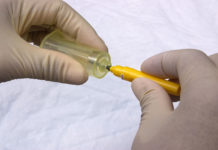
Study presented at ENDO 2019 shows that ovarian function in transgender men on testosterone therapy is preserved even one year later
Ovarian function in transgender men is intact even after one year of treatment with the male hormone testosterone. According to a study presented at ENDO 2019, the Endocrine Society’s annual meeting in New Orleans, La, transgender men preserve their fertility potential even after a year.
“Our research shows for the first time that after one year of testosterone treatment, ovary function is preserved to a degree that may allow reproduction,” said the study’s lead investigator, Yona Greenman, M.D., deputy director of the Institute of Endocrinology and Metabolism at Tel Aviv-Sourasky Medical Center in Tel Aviv, Israel. “This information is important for transgender men and their partners who desire to have their own children.”
Transgender men often choose to receive testosterone as a gender-affirming treatment. However, some transgender men may later want their own children through either a surrogate or their own pregnancy.
Transgender men often choose to receive testosterone as a gender-affirming treatment. However, some transgender men may later want their own children through either a surrogate or their own pregnancy
“Because the long-term effects of testosterone therapy on fertility are unknown, the current recommendation is to stop testosterone at least three months before fertility treatments,” said Greenman, who heads her medical center’s Transgender Health Center.
Her research team studied 52 transgender men receiving testosterone therapy over 12 months. Participants ranged in age from 17 to 40, with an average age of 23. Seventeen participants were in a stable relationship, and only four (7 percent) had already undergone fertility preservation by freezing their eggs. About two-thirds either expressed a desire to have their own children (17 percent) or were unsure about parenthood (50 percent), Greenman said.
The researchers measured hormone levels in the blood and performed pelvic ultrasound to measure ovarian factors that reflect fertility. Complete data were available from 32 participants.
Even with the expected increase in testosterone blood levels and decrease in estrogen at one year of therapy, participants had levels of anti-Mullerian hormone (AMH) that remained in the normal range for fertility, according to Greenman. AMH is secreted by small ovarian follicles, and its levels are used to appraise the remaining egg supply, the ovarian reserve. Average AMH levels in this population decreased only slightly, from 5.65 nanograms per milliliter (ng/mL) before treatment to 4.89 ng/mL.
“This level likely indicates well-preserved ovarian function,” Greenman said. Their assumption is corroborated, she added, by the participants’ unchanged antral follicular count, also an indicator for estimating ovarian reserve.
“Although there is a need to investigate the effects of testosterone on further fertility parameters such as quality of oocytes and in vitro fertilized embryos,” Greenman said, “these results are a further step toward providing transgender people basic rights such as reproduction.”
In participants, the thickness of the lining of the uterus, or endometrium, also was unchanged. This is important because a thick endometrium is critical for implantation of an embryo and a successful pregnancy, Greenman said.
A growing percentage of the U.S. adult population identifies as transgender: 0.6 percent in 2016 versus 0.3 percent in 2011, according to The Williams Institute at the UCLA School of Law.












